Whole Food vs Supplements
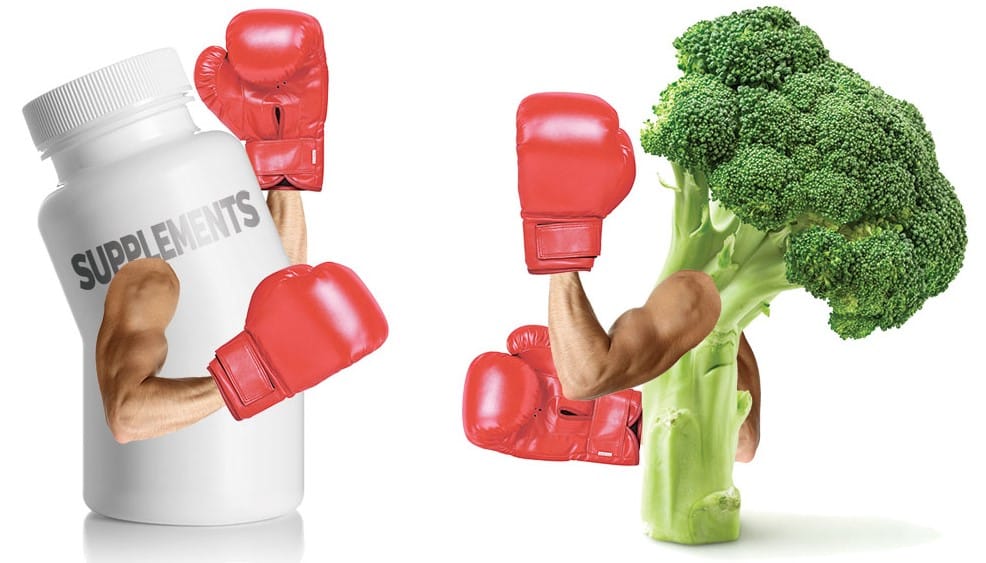
Is it possible for athletes to achieve optimum performance through healthy diet alone?
You eat a reasonably good diet, get in some green veggies every day and try to limit the junk food, right? Why then do you need to use nutritional supplements at all? You don’t. Unless you want to achieve optimum levels of performance.
The body is a remarkable machine. It will take just about any food you feed it and turn it into power in order to train. There are a few world-class athletes who train on fast food diets, but they aren’t as good as they could be. There is a dirty little secret the whole food zealots and gurus don’t want you to know. Here it is: even if you are eating 100% clean and healthy, your body is missing critical nutrients, vitamins and minerals, and you are not achieving your optimum performance! In this article we’ll explain why.
Nutrient Density
The food you eat today is less nutrient dense than food from the past. For example, the broccoli that you purchase in the grocery store is most likely from a hybrid strain known as Marathon. Researchers at the US Department of Agriculture found that Marathon broccoli is about one third lower in calcium and magnesium than other hybrids. Those other hybrids were already 50% lower in calcium and magnesium than the broccoli tested for the 1998 USDA nutrient database.
Agriculture is big business and farmers know what sells in supermarkets. That influences what strains they choose to grow. The first thing a farmer must consider is pest resistance and speed of growth. If a crop gets eaten by bugs, or can’t go from seed to harvest quickly enough, that farmer is out of business. You probably won’t be surprised to learn the fast growing pest resistant crops are not always the most nutritious.
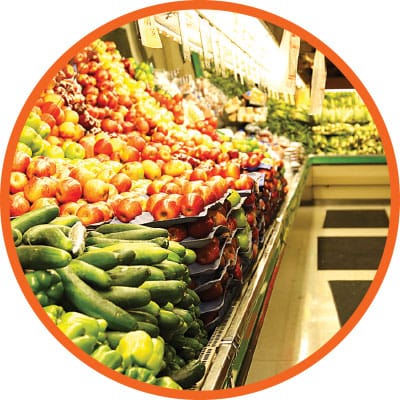
The farmer’s next concern is durability. If the produce can’t get to the store in one piece, nothing else matters. So, farmers select strains that contain a lot of water and pith (a fibrous support structure) that helps durability, but not nutrition. The third thing a farmer looks for is appearance. Will the produce look good sitting on the shelf? If it doesn’t look almost perfect, no one is going to pick it up and buy it. (How many times have you picked up an apple that looked great only to find out it tasted bland and mealy?)
Finally, we come to taste and what sells best in fruits and veggies? A sweet taste. That means that strains that produce a lot of natural sugars are going to be selected over other strains that may be healthier. The level of nutrients in the food is never actually considered in mainstream agriculture when deciding what to plant and sell, but that’s not the only problem.

Soil Depletion
Conventional agricultural practices have depleted the soil of many important vitamins, minerals and nutrients. Today’s fast growing strains of crops have less time to absorb what is left. This leads to produce with vastly reduced mineral content.
We understand the major minerals and how important they are to good health, but we’ve only recently begun to understand the role of phytochemicals, trace minerals, flavonoids, and antioxidants in our food. Unfortunately, the news here isn’t any better.



Artificial Ripening
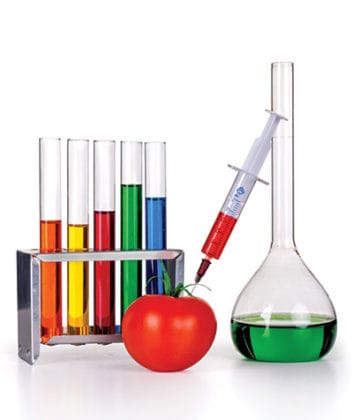
Many plants are harvested ‘green’ and then ripened artificially with the plant hormone ethylene. This is true even for organic fruits and vegetables. The use of ethylene for post-harvest ripening of fruits is sanctioned in the United States National Organic Standards Board guidelines. Artificially ripening means plants never get a chance to develop a multitude of nutrients like anthocyanins, which require sunlight during the ripening process to develop. Anthocyanins and other flavonoids can provide protection against DNA damage, brain cell deterioration, cancer, and a host of other health problems, but we aren’t getting nearly the amount that nature intended through our food. These valuable compounds are simply missing from modern fruits and vegetables.
Researchers in Spain studied the process of ripening cherries and listed 14 different stages in the natural process. They found that when growers picked the cherries at stage 8, which was typical, they only contained about half as much Vitamin C versus being picked when fully ripe. Researchers at Oregon State University found similar results when they studied blackberries. The naturally ripened berries contained almost 4x as many anthocyanins as the unripe berries.
Digestion Woes
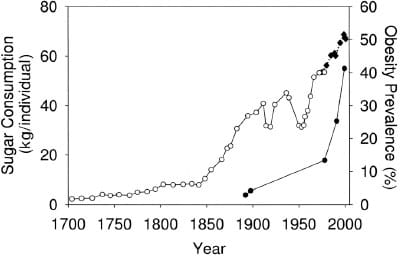
Back in 1957, Professor E.V. McCollum, who was considered America’s top nutritionist at the time, published a book called, “A History of Nutrition.” This book largely refuted all the previous studies that had shown how damaging excess sugar was to health for humans and other animals. The book became wildly popular and in a short time sugar was being dumped into every food you can imagine, from hot dogs to pasta to yogurt to bread. Sugar consumption started to go through the roof.
By the way, the book was published and marketed by a company named “The Nutrition Foundation, Incorporated,” which was an organization funded by the American Sugar Refining Company, Coca-Cola, Pepsi-Cola, General Foods, General Mills, and about 40 other food manufactures that stood to benefit from selling more sugar-laden, refined foods.
All this extra sugar plays havoc with your digestive system, including crowding out the ‘good’ bacteria in your digestive tract and allowing the ‘bad’ bacteria to thrive. This leads to poor digestion and absorption of the nutrients extracted from the food that you eat (which we’ve already seen is compromised in the first place). So, the food is missing all those vitamins, minerals, and flavonoids and you can’t absorb the few that you do eat because your gut flora and fauna is compromised. Poor digestion contributes to many chronic diseases in the US. This problem gets worse the older you are due to a decline in the production of digestive enzymes.
USDA Guidelines are For Your Mom
(And She’s Not Eating Well)
The USDA publishes an updated set of dietary guidelines for Americans every 5 years. The most current publication is the 2010 edition.1 These guidelines are intended as a bare minimum recommendation for everyone over 2 years old, which includes your mom. Even by the low standards in the USDA guidelines, Americans are still undernourished. The chart below shows the percentage of the US Population meeting standards for some key nutrients, even after food enrichment and supplementation!

As an athlete in a demanding sport you are going to have vastly different nutritional requirements than your mom, so it’s extremely unlikely you are getting all the nutrients you need through diet alone.
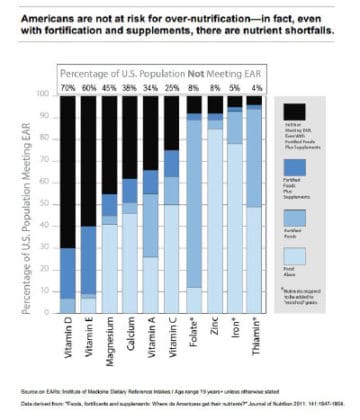
Some Nutrients are Hard to Obtain Through Food
There are some very beneficial nutrients that can be difficult or impossible to obtain through just eating whole foods.
Vitamin A is critical to vision, bone, skin, gene transport and overall immune function. To get your mom’s minimum daily dose, just eat 1 cup cantaloupe, 2 cups of raw spinach, and 1 medium carrot every day. (cantaloupe, spinach and carrot)
To get your daily dose of calcium you’ll need 3 8oz glasses of milk or yogurt. (glass of milk x3)
Potassium is important for bones, muscles, nerve function, hydration, and energy production. You should be getting at least 4,700 milligrams per day. That’s just 10 cups of cooked broccoli (try to get the good kind) or about 7 sweet potatoes. Of course you could just do 5 cups of broccoli and 3 ½ sweet potatoes on some days. (broccoli x 10)

As an athlete you should be getting 1.7 grams/kilogram of protein per day. For a 185lb fighter that equals about 140g/day of quality protein. So you’ll just need 7 eggs or 6 chicken breasts or 19 glasses of milk. Of course feel free to mix and match. (egg x 7)
There are many more basic or essential nutrients that turn out to be difficult to get every day through your diet alone. There are also some beneficial nutrients that are much easier to supplement than obtain through diet. One example is blueberry extract.
Blueberry extract has been shown to protect brain function and cognition, reduce inflammation, slow aging, reduce obesity, and help with metabolic syndrome. While it would be almost impossible to eat enough blueberries to achieve these effects, supplementing with standardized extracts is simple and cost effective.

Conclusion
While it is possible to live a happy and healthy life just eating whole foods, it’s difficult to impossible to give your body everything it needs for optimum performance on the mats and health through diet alone. You can use dietary supplements as part of a well-developed strategy for peak performance to make up the gap where whole foods fall short.

